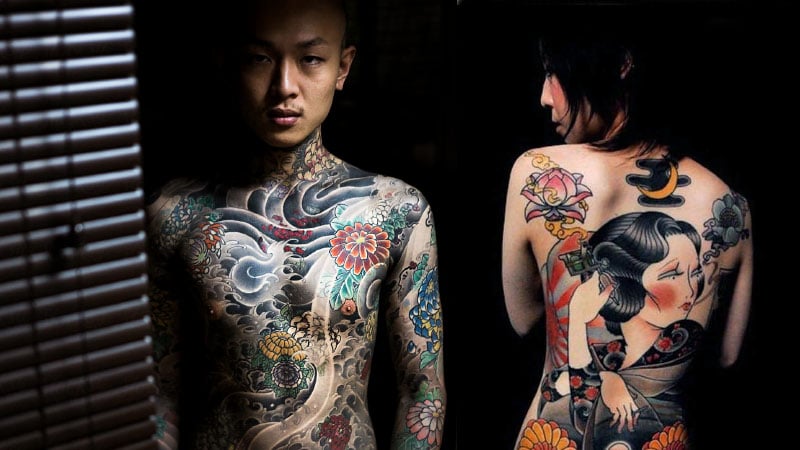
Japanese tattoos are expressive and bold, which is why they’ve become a style that is loved around the globe. The vibrant colors and the interesting shading makes these inkings eye-catching and exciting. The imagery used is often a way to honor folklore or tradition, and common designs include mythical beings, such as dragons and phoenixes, nature, animals, and the supernatural. As striking as this technique is, it’s also shrouded in controversy. The Yakuza gang is synonymous with body art, inking their entire bodies to show their commitment and strength. For this reason, tattoos carry a stigma in Japan. Find out everything you need to know about this impressive technique!
What are Japanese Traditional Tattoos?
Japanese traditional tattoos are also referred to as Irezumi. It is a tattooing technique that is ancient and rich in symbolism. The body art usually involves several different themes, which may be inspired by folklore or tradition, with common imagery including koi fish, dragons, geishas, and flowers. The style is distinct, identifiable by the vibrant colors and interesting, meaningful subject matter. These inkings have become popular around the world, with many people feeling inspired. However, it is essential to know that some images can be deemed offensive, such as inking religious designs or ones that others interpret as having a dark history.
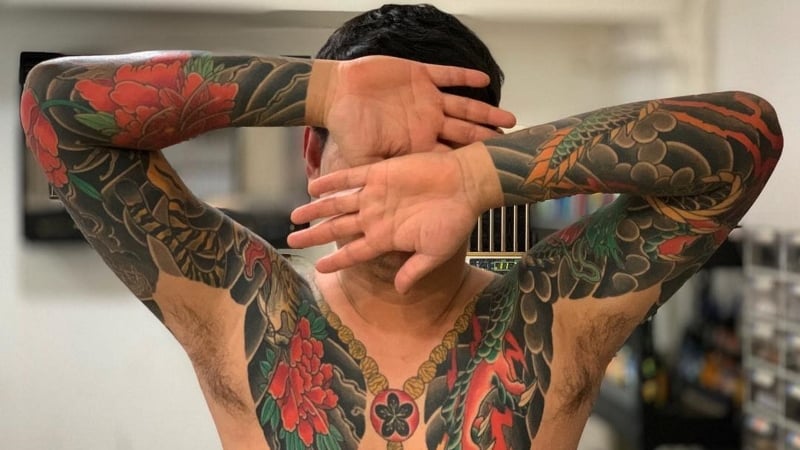
What is a Yakuza Tattoo?
Japanese tattoos are beautiful, bright, and expressive, but they have a bad reputation because of their association with the Yakuza. The criminal gang is known for covering their bodies in ink, which is a way to mark the members for life and show their loyalty and ability to endure pain. At one point, tattoos in Japan were illegal, which was another reason the gang adopted them. That said, in the 21st century, some Yakuza do not ink their entire bodies as it is easier to blend in with the rest of society.
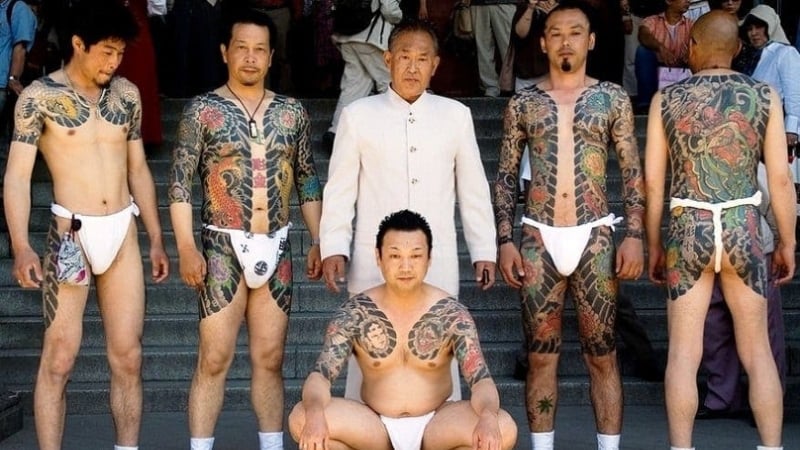
Colors Used in Japanese Tattoos
The subject matter in Japanese tattoos is incredibly important, but so is the color. Although several black-and-gray combinations are detailed and meaningful, the technique is also identifiable by its brightness. There are various color schemes to choose from, depending on your subject matter, and each carries different symbolism. For example, a black koi fish is associated with masculinity, adversity, and perseverance, while a green dragon is connected to nature.
Red
Red is one of the most vibrant colors used in tattoos because it instantly makes a statement. In the Japanese technique, it represents many things, including strength, passion, and blood. Shrines and temples may be painted in red, and the color is incorporated into significant events and even the national flag. It is also believed to ward off evil spirits and can be symbolic of peace and economic success.
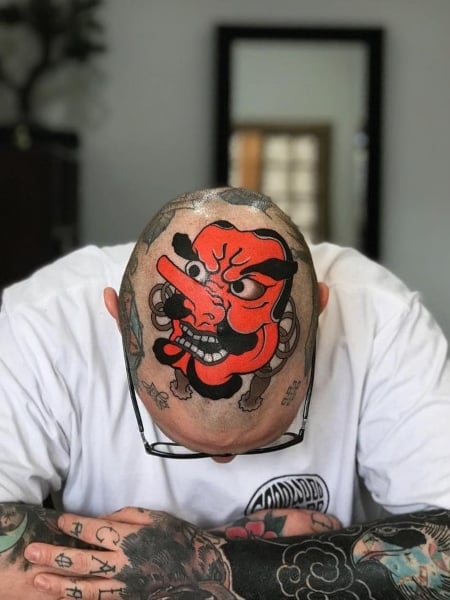
Blue
Blue is a popular color for Japanese clothing and is often worn in the workplace, with recruitment suits being sold in various shades. It can be associated with hard work, fidelity, and acceptance. As you can see, it also makes for a beautiful tattoo.
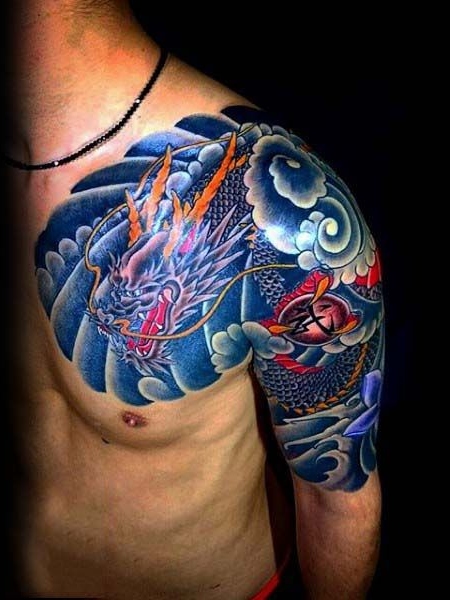
Black
Black is a popular color for tattoos, and you will see many black and gray designs which are both striking and detailed. Lettering is usually done in black ink, and it is associated with mystery or mourning. It is an intense shade, often viewed as masculine, and it has a rich history in tattooing; depending on your chosen design, it can have even more meaning attached to it. For example, a black dragon is symbolic of wisdom, and a cat of the same color can ward off evil.
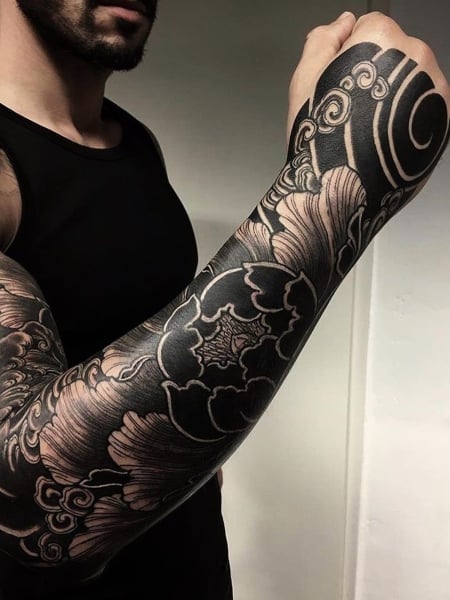
White
White is a popular and sacred color in Japan. It can represent mourning and death, as well as purity, peace, and honesty. For some, it is associated with new beginnings and is linked to the spiritual world. For tattoos, it creates an exciting contrast when inked with black or gray and is a wonderful way to add more details.
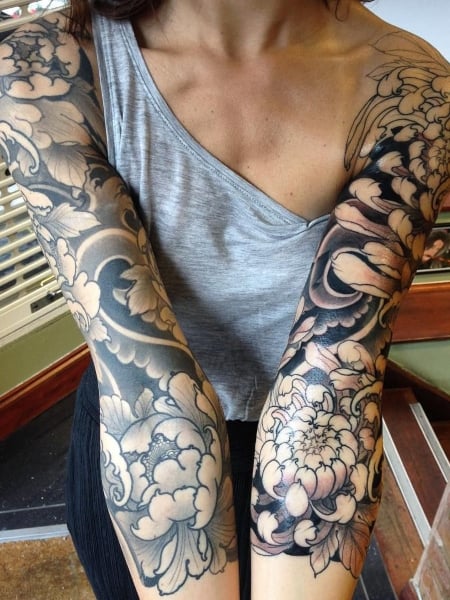
Purple
Purple is a stunning color for body art because it is so bright, but it is also meaningful in Japan. In the country, this shade is associated with royalty and strength. In the past, it was one of the most expensive colors to produce and therefore was reserved for those who were able to pay for it.
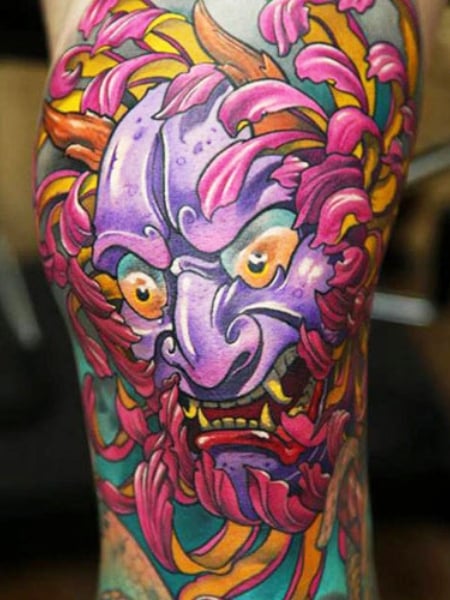
Pink
Pink is a feminine color associated with female power, beauty, and good health. It is also commonly used in Japanese body art, especially with cherry blossom tattoos. It is an excellent way to add some brightness to your tattoo, but it also has a softness to it.
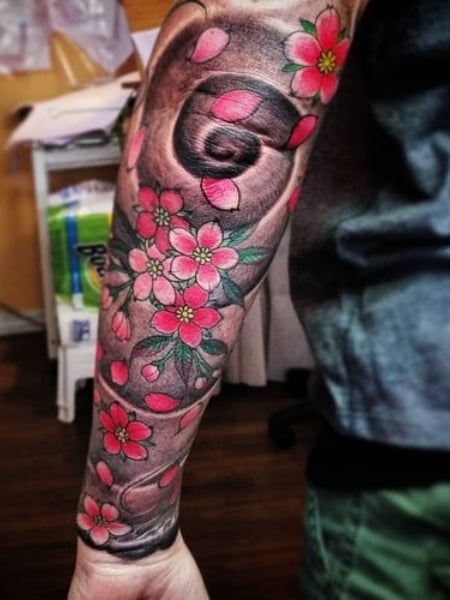
Green
Green is a color that represents nature and life. In Japan, it is also associated with energy and vitality. The vivid color makes for fantastic body art, adding extra meaning to your chosen design.
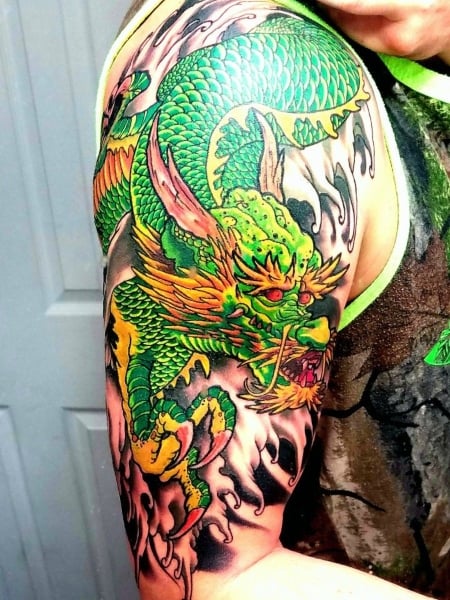
Yellow
There are few colors as striking as yellow, the color of warmth, joy, and prosperity. It is symbolic of the sunshine and is a shade that can bring a smile to your face. In some areas of Japan, it is considered a sacred color, while in others, it has a negative association. It compliments a wide range of body art, from flowers to dragons, and is bound to turn heads. On the other hand, gold is linked to power and the Gods and adorns shrines and temples.
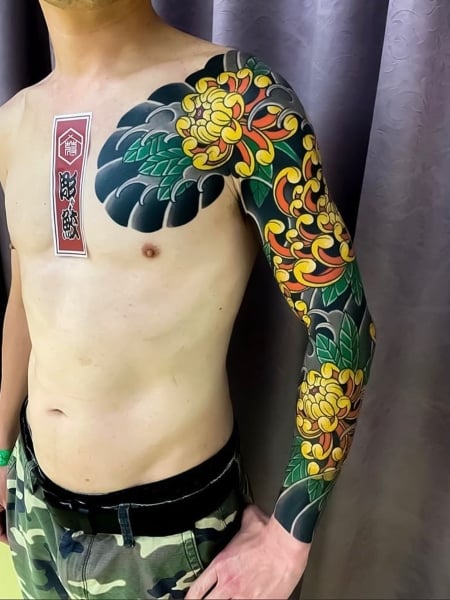
Japanese Tattoo Designs
1. Cat Tattoo
Cats are often associated with wealth and good luck and therefore make for great tattoos. There are various ways to design your cat tattoo, and while some people opt for the more traditional approach, others may pick out things that they appreciate about the Japanese culture. This could be anything from the food and dress to the tattoo style. It is essential not to be offensive with your design, and it is always best to avoid sacred and religious imagery.
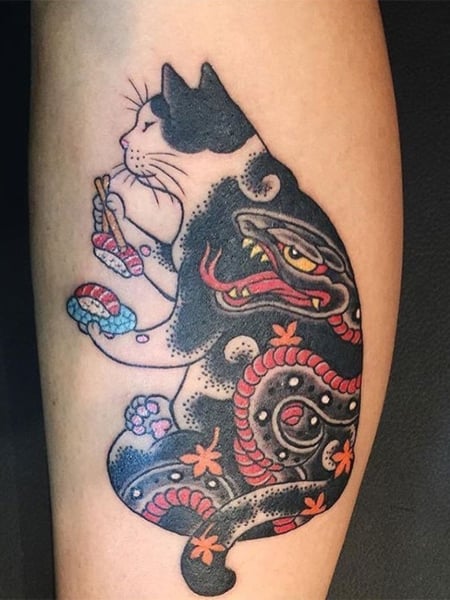
2. Cherry Blossom Tattoo
Cherry blossoms are one of the most beautiful flowers, and their pretty pink color makes them a welcome addition to any landscape. That said, they do not live for very long, which makes the bloom symbolic of life and its impermanence. The flower is also connected to strength and perseverance and is a common image used in Irezumi because of its beauty and meaning.
In Japan, the cherry blossom season is when the flowers bloom, and it is a time that is celebrated; therefore, it can also be associated with joy.
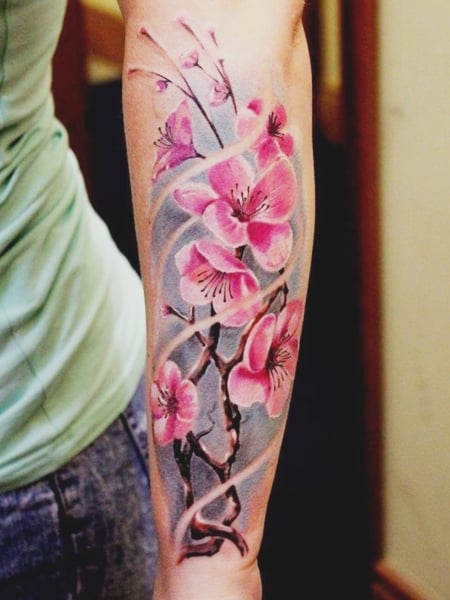
3. Cloud Tattoo
If you want a stunning, decorative tattoo, you may be drawn to the Japanese cloud design. The bold wisps are referred to as Kumo and can be inked on their own or as fillers with other imagery. The clouds are an admiration of nature and a symbol of important ideas, masculinity, impermanence, and change. They tend to look best when kept dark and make a very bold statement.
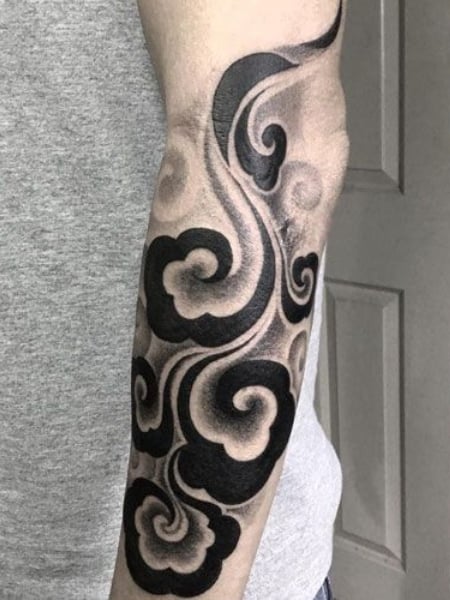
4. Crane Tattoo
The crane holds great importance in Japan and is seen as a symbol of peace and hope. It is also considered an otherworldly creature and is deeply respected and admired, and has been the subject of interesting legends. The bird can bring luck and good fortune but also represents longevity and wisdom. The design is usually detailed and may include other imagery such as a sun or flowers. It, therefore, requires a placement option with enough space to allow for these details. The arm or thigh are great spots, as you can see them often, but you also have more room to create bold and colorful artwork.
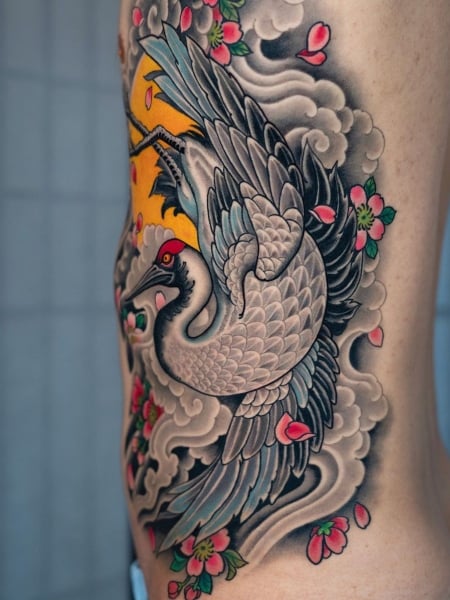
5. Demon Tattoo
A demon tattoo may not be a design that appeals to everyone, but there is a very interesting meaning attached to it. The most popular image is Oni, a type of ogre or demon depicted in Japanese folklore. Your ink can represent the balance between good and evil, and it could be a reminder that harmful acts will not go unpunished. The wearer may also wish to intimidate others with their body art and give off the impression that they are not to be messed with. These pieces are also exceptionally detailed and often feature other images, such as cherry blossoms or a snake, making for a statement inking.
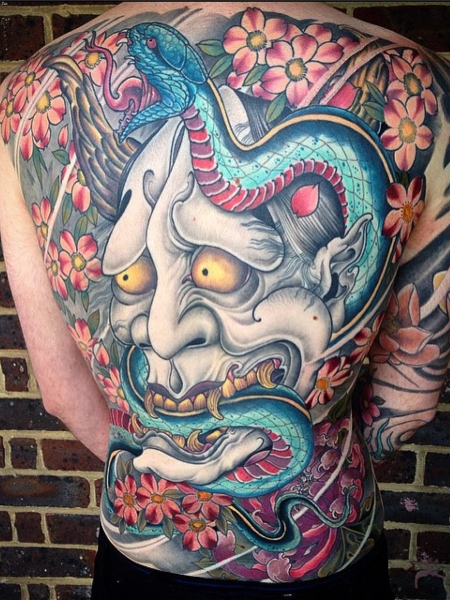
6. Dragon Tattoo
Dragon tattoos are some of the most popular designs because they are so interesting and symbolic. The mythical creature has great significance in Japanese culture and represents bravery, strength, and wisdom. This is a stark comparison to what dragons represent in the West and are often seen as evil or greedy. When it comes to placement, the arm or leg are top spots to get it inked because the creature’s shape looks as though it is wrapping around your limbs; this makes for a particularly interesting inking. There are also many colors to choose from, each with their different meaning. Black is associated with wisdom, and green with nature, while yellow dragons are noble. You can determine which appeals most to you, but red and black are a very striking combination.
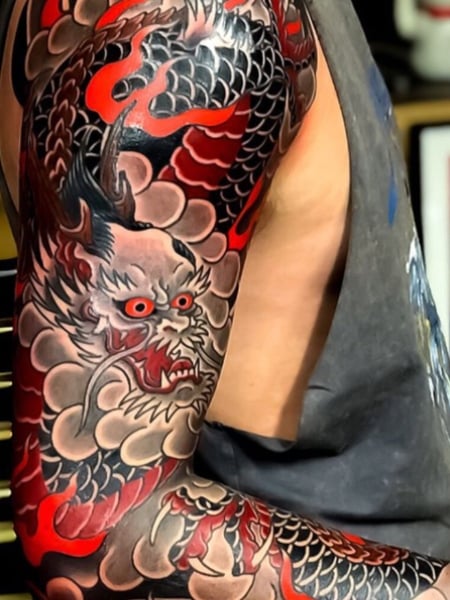
7. Flower Tattoo
Flower tattoos are fantastic choices for both men and women. You can choose to get inked with just one or several blooms or let them form part of an intricate design that includes other images such as a dragon, phoenix, or koi fish. Several flowers are important in Japanese culture. These include the lotus, peony, and cherry blossom, each of which has its symbolism, but the plants, in general, are commonly associated with life and beauty. The Japanese style uses bright colors, making your ink hard to miss and a fantastic option if you want something that makes a statement.
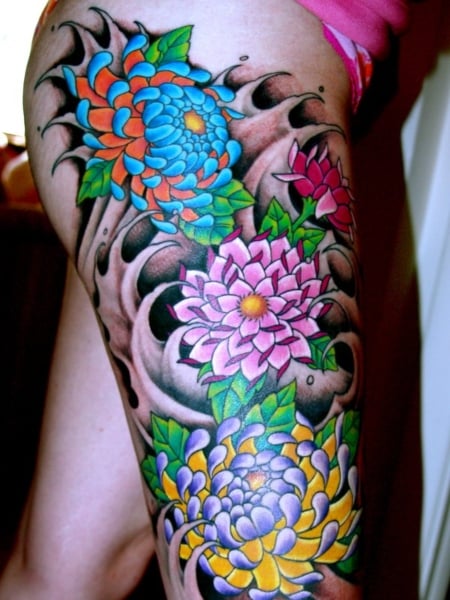
8. Foo Dog Tattoo
If you want a tattoo that represents protection and good fortune, then you need a foo dog. The mythical creature looks similar to a lion and is important in Japan. It is an architectural ornament designed to guard important buildings and shrines. They represent prosperity, good fortune, and protection and are a fantastic choice for a tattoo. This interesting beast also inspires people in the Western world, and if you love the symbolism associated with it, it will make a great choice for your next inking.
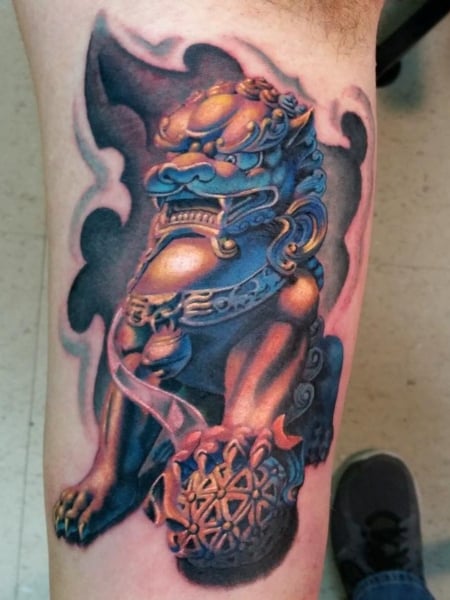
9. Frog Tattoo
Japanese frog tattoos are not your average amphibian design! They are bright, multicolored, and often look particularly fierce. Some artwork may also include gold coins. They are interesting to look at and rich in symbolism. The choice is yours of how you wish to portray your frog or toad, and the imagery you include may alter your piece’s meaning. That said, in general, it is regarded as a lucky animal that brings prosperity, success, and good fortune.
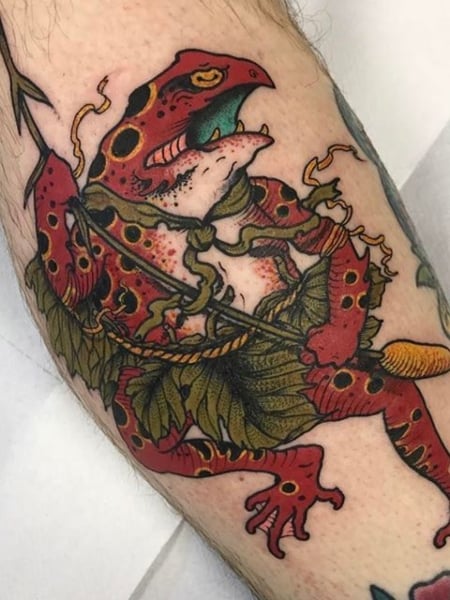
10. Japanese Women Tattoo
Geishas have an important history in Japan and are often associated with attractiveness, femininity, and grace. A tattoo of a geisha, or a Japanese woman styled as one, is an inking for both men and women and represents perfection, respect, and intense beauty. It is also seen as a symbol of Japanese culture. Most of these pieces are large and detailed, with the back being a popular placement option to allow for enough space. You can also add other traditional images, such as a cherry blossom or a samurai, depending on the meaning that appeals to you.
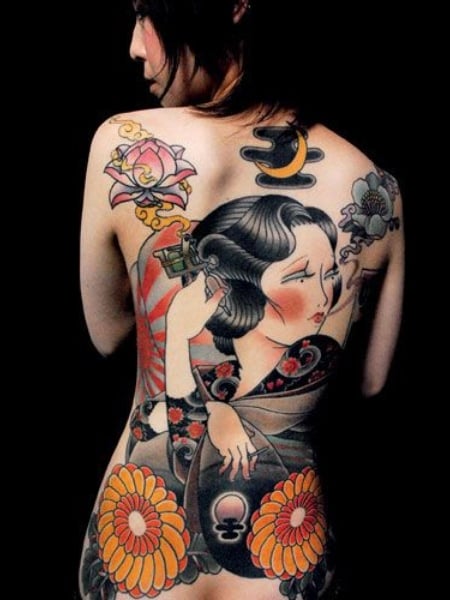
11. Koi Fish Tattoo
Do you want body art that represents strength, accomplishment, success, determination, good luck, and so much more? Then a koi fish tattoo is a perfect design for your next inking. In Japanese body art, this is one of the most popular images used because of the carp’s importance and symbolism. They can also have various meanings depending on the color. For example, red represents love, power, and motherhood, while black is associated with adversity and a struggle to succeed.
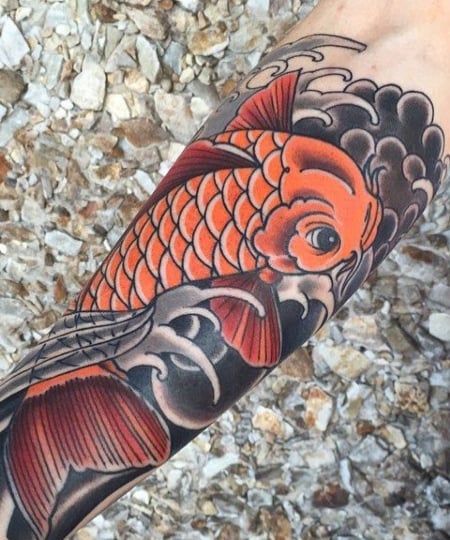
12. Letter Tattoo
Sometimes people want to get inked with a word or phrase, but they do not want others to understand its meaning easily. It is for this reason, foreign languages and symbols are often favored. Kanji is beautiful, and it makes for an interesting and symbolic tattoo. There are some drawbacks to getting this type of design, though. If you have not done enough research and do not understand the language, it is easy to get inked with something that has an entirely different meaning to what you initially intended it to have. If you are inspired by Japanese culture, this may also be a way to honor it.
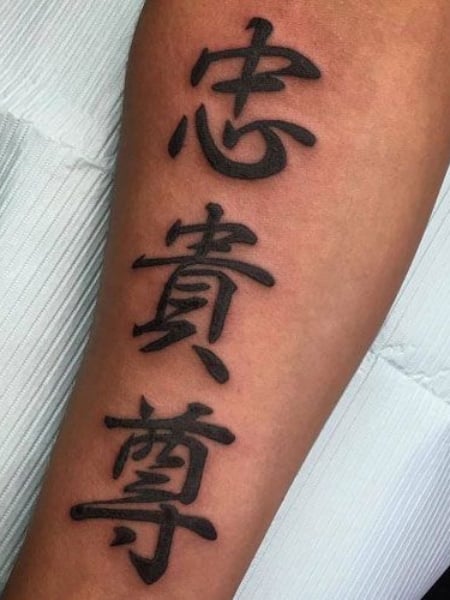
13. Lion Tattoo
A lion tattoo represents courage, royalty, and strength for many people, but they are not depicted in Japan as you would see them on the African plains. Instead, they have pointed ears and a wispy mane, giving a somewhat intimidating but also mythical appearance. They are common statues to guard the entrance of important places and are designed to ward off evil and offer protection. Your body art can have the same meaning. It is a strong design, often shown with its teeth bared, for those who want something fierce and powerful to keep them safe and remind them to stay on the right path.
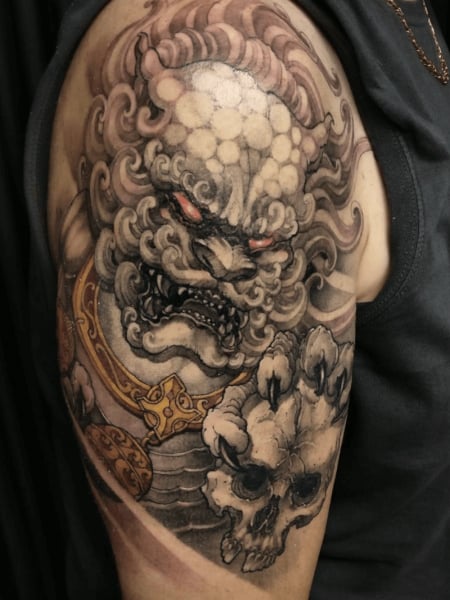
14. Lotus Tattoo
A lotus tattoo is a popular choice because it is rich in symbolic value. They are valued in Japan, and you will often see them being inked either on their own or with a water theme. For example, a piece that features a koi fish. The bloom is often associated with enlightenment and spiritual awakening. However, it also represents purity and strength. The beautiful flower grows in muddy waters, and many people are inspired by this, as it serves as a reminder that when life is hard, you can still find beauty in it. Or it can be interpreted as a way never to give up and continue to persevere.
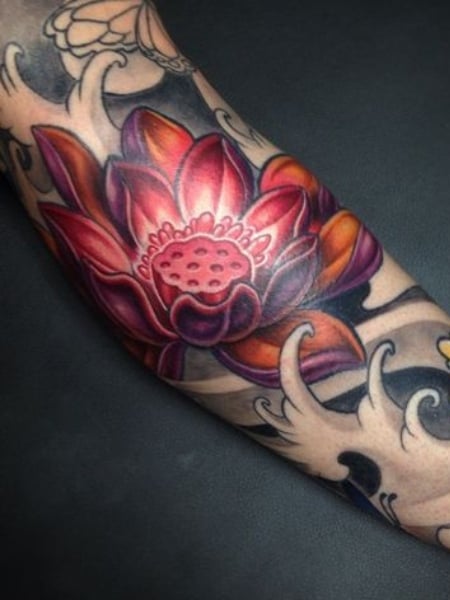
15. Mask Tattoo
There are several Japanese masks, some worn for religious events and others for theatrical purposes and festivals. Your inspiration will determine your design. One popular choice for body art is the Hannya mask. You may feel it is dark or scary when you see it, but it is a symbol of good luck and is used to ward off evil. There is also a story of how it represents a woman consumed by passion and love, which is an appealing interpretation for those who have had their hearts broken or their affection rejected.
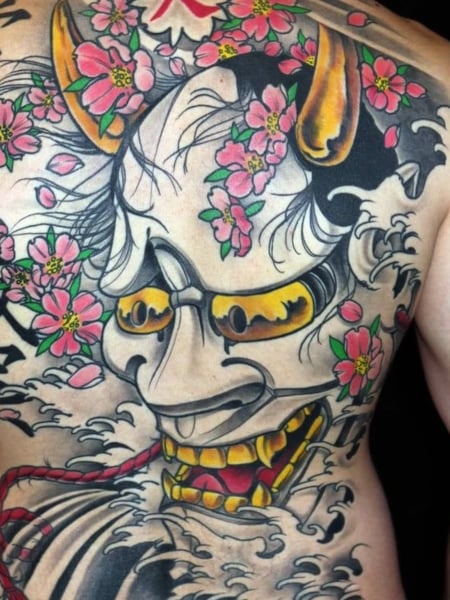
16. Peony Tattoo
In many Japanese tattoos, you may see designs including the peony. It is a beautiful flower and often inked in various bright colors, making for a bold and meaningful tattoo. It symbolizes prosperity and good fortune but is also linked to life, perseverance, bravery, and honor. You can choose to get inked with a series of these blooms or add various other images, for example, a geisha or a crane, which adds even more meaning to your body art.
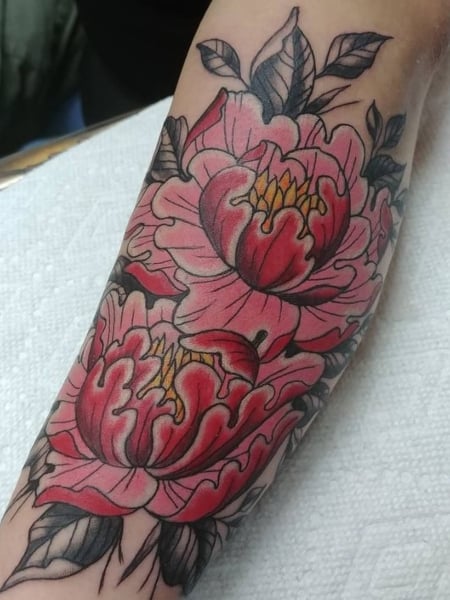
17. Phoenix Tattoo
A phoenix tattoo is often associated with birth, death, and rebirth. Referred to as Hou-ou, the Japanese phoenix is a mythical creature representing fire, justice, and power. It was also used to decorate homes, and it is believed that those who lived there were honest and loyal. It is a beautiful bird and rich in symbolism and is one of the most popular choices to get inked because of this.
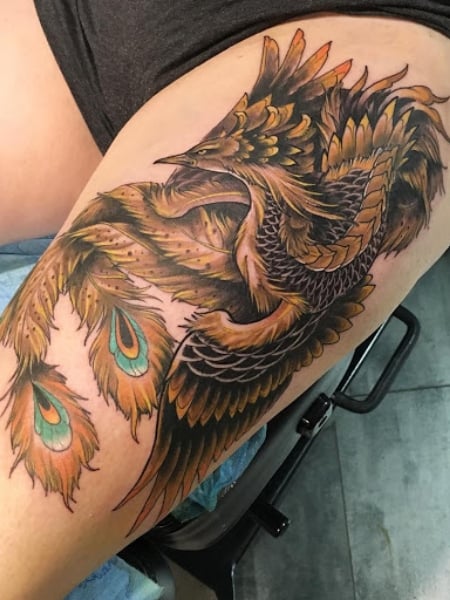
18. Skull Tattoo
A skull is a universally recognized symbol of death, and it may seem like a morbid choice for a tattoo. That’s not necessarily the case, though, as it can also represent how fleeting our existence is, and therefore, the importance of valuing our lives and living well. The Japanese skull tattoo is symbolic of change. It can be accompanied by various other images, with popular choices including flowers, which can add to your ink’s overall meaning. Color also plays a role, so choose wisely.
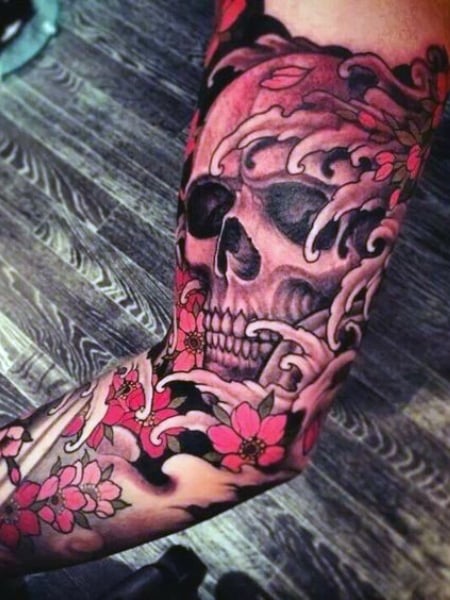
19. Snake Tattoo
One of the most popular symbols you will see in the Japanese technique is the snake tattoo. It can be a symbol of change, protection from diseases and illnesses, and can also prevent bad luck. This may seem surprising considering the serpent’s intimidating appearance, often depicted coiled and seemingly ready to strike. However, the creature is not regarded as evil and instead brings the wearer good luck and strength.
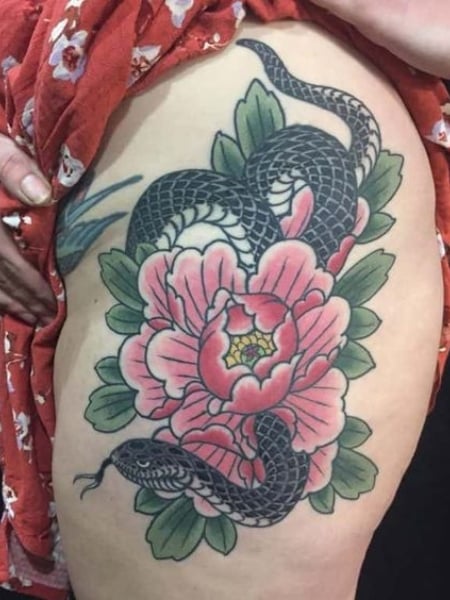
20. Sun Tattoo
Japan’s rising sun, the bold red design, has been used in flags and is symbolic of divinity, courage, and life. It is a symbol that, for some, represents the country. There are many different designs, and some include warriors while others feature waves or temples. It is, however, a very controversial image. As an important note, for some people, this design can be incredibly offensive. It was used as the flag of the military, and for the countries that were invaded during this time, it represents a very dark part of history.
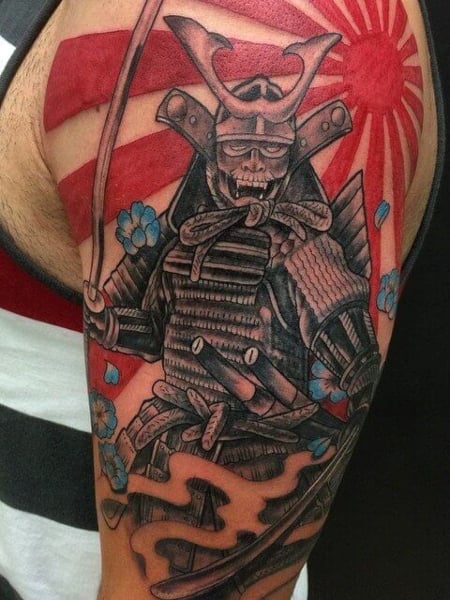
21. Temple Tattoo
Many Japanese temples are architectural masterpieces that have survived for centuries. They are a place of spiritual awakening and growth and indicate a connection between this life and the next. It could be a way to honor your faith, show respect for the culture, or a reminder to stay on the right path and do good in life. It is not hard to see why an image of a temple would be such an appealing tattoo, but inking religious imagery can be offensive to some people. Hence, it is always best to do your research beforehand.
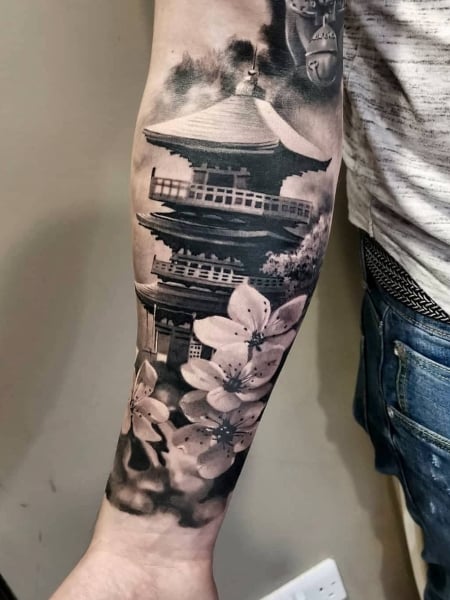
22. Tiger Tattoo
Tigers are fearsome and respected predators that are often regarded as protectors and symbols of strength and power. In Japanese tattoos, they are viewed as a way to keep away negative energy, evil spirits, sickness, and disease. These beautiful big cats are depicted as being ferocious and intimidating, making them the perfect body art for someone who wants a meaningful inking that can instill fear in others. It is best to complete the tiger tattoo design in color, which makes for an impressive and striking piece. It also requires a large area of skin to allow for the full detail and glory. For this reason, the back or thigh are great options.
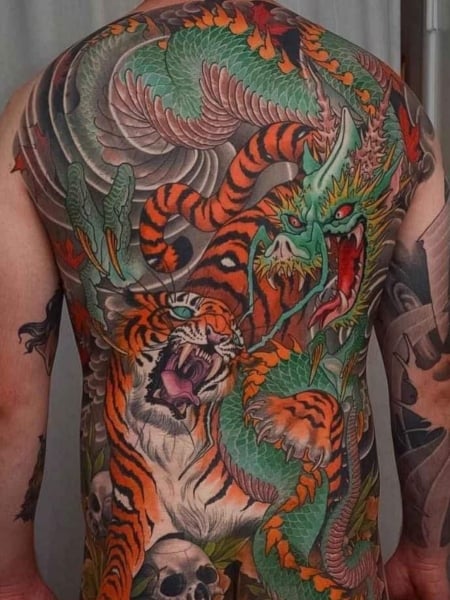
23. Wave Tattoo
Waves are a fantastic image to tattoo because they represent strength and life. They are also symbolic of change, as water is a recurrent pattern of coming and going. This can be linked to life, as we experience ups and downs, and we live and die. Or, for some, it could be interpreted as a way to go with the flow and accept the situations you find yourself in. The wave symbol is shown as an arch and can be inked in black and grey or blue. It also is associated with good luck and resilience.
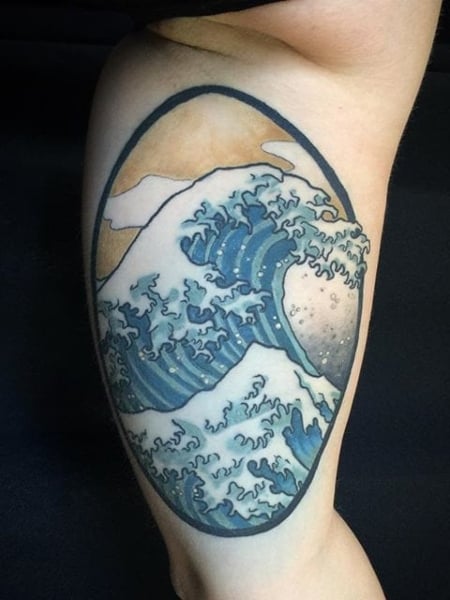
24. Wolf Tattoo
Wolves can be inked to honor Japanese culture or show respect for ancient traditions or beliefs. The canines are associated with Shinto gods and are believed to act as messengers in the spiritual world. They are seen as strong and powerful and can be protectors. Many different wolf tattoo designs have evolved over the centuries, but you will most likely see interpretations of this animal as having an intimidating appearance. The wolf’s fangs may be bared, which makes for a mighty and fearsome tat. It could also act as a warning to others not to mess with the wearer.
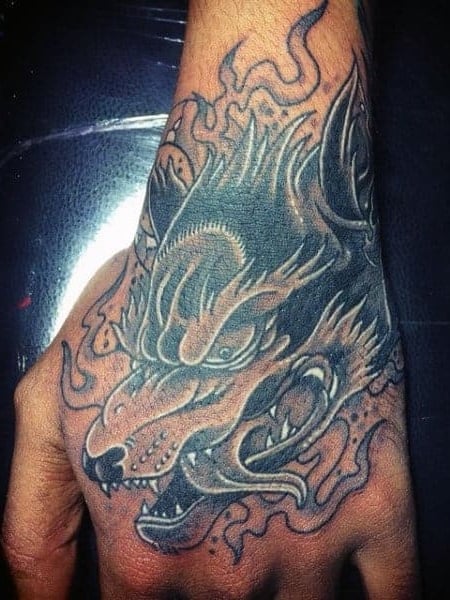
25. Words Tattoo
Words are so meaningful because they can be of anything. Maybe it is a phrase that inspires you, a verse from your favorite poem, or lyrics that have stuck in your head. Regardless of the reason, words make for a beautiful and symbolic tattoo. If you have deep respect for the Japanese language and find the symbols beautiful, this could make an interesting and meaningful inking. You can also include imagery of other important Japanese elements, such as the yin yang or cherry blossoms, to make for an intricate piece. Of course, you need to do your research beforehand to ensure that your artwork has the intended meaning and is in no way offensive.
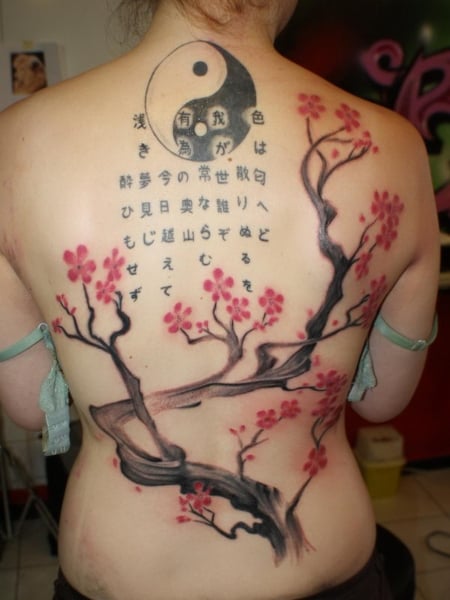
Japanese Tattoos FAQs
Are tattoos illegal in Japan?
Tattoos are not illegal in Japan, but there was a time when they were as the government viewed individuals with them as being troublesome. Body art is also associated with the Yakuza. The criminal gang is known for covering their bodies in ink to show their loyalty and mark themselves; thus, there is a stigma attached to tattoos. Tourists visiting Japan may also want to cover up their tats as they could be seen as offensive.
Is it OK to get a yakuza tattoo?
It would not be wise to get a Yakuza tattoo if you are not affiliated with the criminal gang. Although tattoos are no longer illegal in Japan, there is still a stigma attached to them, especially with the older generations. These days, it is also believed that the Yakuza themselves choose to avoid visible inking as it allows them to better blend in with the rest of society.
What are traditional Japanese tattoos called?
Traditional Japanese tattoos are called Irezumi. It is an ancient art form and an incredibly expressive one. These days, the style has become popular around the globe. It often features vibrant colors and specific themes, including supernatural images, mythical beings, nature, and animals. Each design is rich in symbolism.
Why are tattoos bad in Japan?
Despite tattoos no longer being banned outright in Japan, they do carry a stigma. This is because body art is often associated with the criminal gang, Yakuza. The younger generation may be becoming more accepting of ink, but it is still offensive to some. It is also incredibly rare to see exposed tattoos in the country. You may also find signs that say 'no tattoos allowed' at certain establishments.

Cailyn Cox holds a degree in journalism and has been working with The Trend Spotter as a writer for over ten years. She has worked with some of the most prestigious women’s and men's lifestyle publications. For her, writing is not just a job; it’s a passion, which is why each article she writes is approached with such enthusiasm and dedication. She has extensive knowledge of hairstyles, tattoos, and beauty and has made a career out of creating informative articles that appeal to women and men of all ages.
SUBSCRIBE TO OUR NEWSLETTER
Subscribe to our mailing list and get interesting stuff and updates to your email inbox.